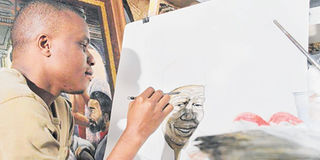Sky is the limit for this self-taught artist

Amani Abeid has been drawing ever since he was a child
What you need to know:
Despite the weather, it took me less than an hour to reach the art space which upon arriving it took me a few seconds to realise that I was in the right place.
It was a chilly Wednesday afternoon, the rains were heavily pouring in most parts of the city as I was on my way to visit Amani Abeid, 30, a self-taught artist in his office located at Nafasi art space, Mikocheni.
Despite the weather, it took me less than an hour to reach the art space which upon arriving it took me a few seconds to realise that I was in the right place.
Welcomed by voices of choreographers practicing, the place looked busy and lively with offices covered with rainbow colours seen at the vicinity.
I had to walk a short distance from the main gate before reaching Amani’s office, which was located on the right side of the ground. Like most offices in the area, the outside wall of his office was covered with spray paint graffiti style.
As I entered to what I later came to realise was a container which was partitioned into an office and a workshop, I could see the young man, clad in jeans and hood sweeter, standing with his hands busy doing what I later came to know was palette knife painting. He was painting it onto canvas placed in front of him.
Upon arrival and exchanging greetings, Amani began telling me about his life journey as an artist – from where he started till today being recognized among most successful artists in the country.
Born and raised in Lushoto, Tanga, Amani’s interest in art started when he was still in primary school. “My whole life has evolved around art. I remember when I was in standard three I was the school painter; I used to help teachers draw illustrations. I did also a number of paintings in solons, churches when I was in standard six,” he proudly says.
In 2008, while he was in his advanced level at Jitegemee secondary school, he participated in a drawing competition organised by Prevention and Combating of corruption Bureau (PCCB) in which he emerged victorious and from there on he became involved in various PCCB projects.
Unlike many artists who had to face discouragement and even punishment from parents and relatives who thought that they were wasting their time engaging in arts at a young age, the case was different for Amani who got a lot of encouragement from his mother.
“I am so thankful to my mother for being so supportive since I was a child. She didn’t discourage me after she realised I had this talent. I remember how I used to take her t-shirts and paint them, surprisingly she never scolded me but instead she ended up wearing them. One thing which was in my favour was the fact that I performed very well in school that is why it was easy for my family to accept what I was doing,” he explains.
Upon completing his A level, Amani wanted to pursue a degree in law, however, with a division 1.7 he had to join Dodoma University in 2009 for a Bachelor degree in Project, Planning and Community development of which he completed in 2012.
Despite spending three years at the University the idea of starting to look for a job was not part of his plan, all he wanted was to be self employed by doing what he loved the most – art. .
“I didn’t want to be employed by anyone but rather I wanted to make myself successful by working as an artist. A lot of people, particularly youth believe that one cannot survive without being employed. And many believe that one can’t survive by just being a painter, they think that there is no life asides being a doctor or a lawyer,” he noted.
He went further saying the fact that he doesn’t fully practice his profession does not mean that he doesn’t apply things he learnt at the University. “My work needs planning and I use my planning knowledge I acquired while studying my bachelor’s degree to help me in my daily working environment,” he speaks.
With more than 20 years of experience, Amani’s work has changed over the years. Today he has mastered different types of painting styles; including abstract and realistic painting, comic and illustrations. He has also learnt the use of various median such as coffee, to mention a few.
What differentiates him from other artists is his belief on things he wishes to represent through his art work, “I am one of the artists who loves to go against the rules of art, before I used to draw work that would impress my customers, however for the last one year that has changed. Most of my work now reflects my life, current affairs and things that surrounds me,” he explains.
While he enjoys all the success he has achieved over the years, including participating in various exhibitions within and outside the country – in countries such as German, Sweden, South Africa and Kenya, he has also worked with a number of publishing companies including Macmillan, Oxford and famous authors such as Nyambari Nyangwine.
For Amani sky is the limit, the fact that he is a self-taught artist hasn’t stopped him from learning more about art through books and online. He wishes that people could not limit themselves in learning new things every day.
“We need to change; there are a lot of things we can learn just at the palm of our hands. Ask, read and learn new productive things every day and do not limit yourself. In addition to that, we need to encourage children to learn art, particularly drawing. There is nothing we do today that didn’t involve drawing, that shows how important art is,” he says.
Amani further said he cannot put the blame of dismal penetration of art on the Government since there are a lot of important things that need to be done. None the less the less government’s support is needed. “The growth of art in any country has a direct link to its economy. A country with a good economy can open room for art to grow; this includes investing in galleries, arts schools, among many ventures. But here in Tanzania, we still have poor hospitals, lack of water, electricity is some parts of the country, so investing in art might seem a bit farfetched,” he states, concluding, “The government can still support through providing good policies for the art industry.”



